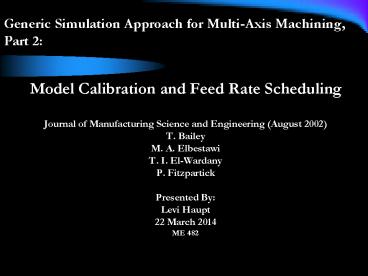Generic Simulation Approach for Multi-Axis Machining, Part 2: PowerPoint PPT Presentation
Title: Generic Simulation Approach for Multi-Axis Machining, Part 2:
1
Generic Simulation Approach for Multi-Axis
Machining, Part 2
- Model Calibration and Feed Rate Scheduling
- Journal of Manufacturing Science and Engineering
(August 2002) - T. Bailey
- M. A. Elbestawi
- T. I. El-Wardany
- P. Fitzpartick
- Presented By
- Levi Haupt
- 22 March 2014
- ME 482
2
Overview
- Development of Least-Squares Fit model of
multi-axis machining - Process optimization for specified parameters
- Determine instantaneous feed rate based on load
prediction model - Improve machining time while maintaining
geometric specifications
3
Outline
- Purpose of Paper
- Methodology
- Results
- Conclusion
4
Purpose of Paper
- Develop methodology to simulate machining of
complex surfaces (Calibrating Coefficients) - Validate simulated results with experimental data
- Demonstrate results through airfoil case study
5
Methodology
- Model Calibration
- Calibration of cutting for coefficients
- Formulate force model to separate cutting force
coefficients and geometric factors - Cutting test performed varying cutting speed,
feed rate, axial depth of cut, radial width of
cut, from test cutting force data obtained - Coefficients found from test data utilizing
Least-Square Fit Regression - Feed per tooth coefficients found from constant
feed rate coefficient - Average Coefficients found from tooth
coefficients
6
Methodology
Calibration Results Solid line coefficient from
step 4 Third graphs comparison of coefficients
7
Methodology
- Feed Rate Scheduling
- Variation of feed rate will prevent tool damage
(chatter) and improve surface finish - Productivity traditionally decreased to improve
process parameters - Process constraints shank and tooth breakage,
chatter limits, surface dimensional error - Utilizing chip load or force constraints will
satisfy all other constraints - Roughing Max force constraint
- Finishing Max chip load constraint
- Feed rate determined for instantaneous cut
geometry and forces based on constraints
8
Results
- Average Coefficient model predictions of loads
within 5 of experimental data - Case Study Airfoil like surface
- 19mm solid carbide ball end mill
- 30 roughing passes
Roughing Stages
Surface Profile
9
Results
Approximately 30 reduction in machine time with
implemented feed rate schedule methodology
Feed Schedule 210 seconds
No feed schedule 293 seconds
10
Conclusion
- Successful analytical model
- Demonstrated accurate force predictions
- Within 5 of experimental data
- Versatile for complex machining surfaces
- Can also be used to predict static and dynamic
tool deflections, dynamic cutting forces - Technical Advancements
- Improved model accuracy
- Improve feed rate scheduling
- 30 reduction of machining time
- Methodology implemented in industry
- Possible limitations
- Excitation of dynamics in feed rate controller
system - Parallel research was conducted (source 17)
11
References
12
Questions?
Happy Halloween!!

